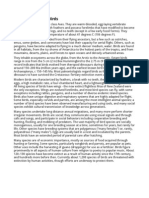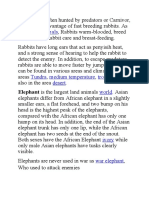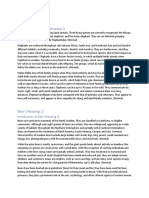Widely Distributed Owl
Widely Distributed Owl
Uploaded by
Anonymous 9LHcz6F0ifCopyright:
Available Formats
Widely Distributed Owl
Widely Distributed Owl
Uploaded by
Anonymous 9LHcz6F0ifOriginal Description:
Original Title
Copyright
Available Formats
Share this document
Did you find this document useful?
Is this content inappropriate?
Copyright:
Available Formats
Widely Distributed Owl
Widely Distributed Owl
Uploaded by
Anonymous 9LHcz6F0ifCopyright:
Available Formats
The barn owl (Tyto alba) is the most widely distributed species of owl, and one of the most
widespread of all birds. It is also referred to as the common barn owl, to distinguish it from
other species in its family, Tytonidae, which forms one of the two main lineages of living
owls, the other being the typical owls (Strigidae). The barn owl is found almost everywhere in
the world except polar and desert regions, Asia north of the Himalayas, most of Indonesia,
and somePacific islands.[2]
Phylogenetic evidence shows that there are at least three major lineages of barn owl, one in
Eurasia and Africa, one in Australasia and one in the New World, and some highly
divergent taxa on islands. Some authorities further split the group, recognising up to five
species, and further research needs to be done to clarify the position. There is a
considerable variation between the sizes and colour of the approximately 28 subspecies but
most are between 33 and 39 cm (13 and 15 in) in length with wingspans ranging from 80 to
95 cm (31 to 37 in). The plumage on head and back is a mottled shade of grey or brown, the
underparts vary from white to brown and are sometimes speckled with dark markings. The
face is characteristically heart-shaped and is white in most species. This owl does not hoot,
but utters an eerie, drawn-out shriek.
The barn owl is nocturnal over most of its range, but in Britain and some Pacific islands, it
also hunts by day. Barn owls specialise in hunting animals on the ground and nearly all of
their food consists of small mammals which they locate by sound, their hearing being very
acute. They mate for life unless one of the pair gets killed, when a new pair bond may be
formed. Breeding takes place at varying times of year according to locality, with a clutch,
averaging about four eggs, being laid in a nest in a hollow tree, old building or fissure in a
cliff. The female does all the incubation, and she and the young chicks are reliant on the
male for food. When large numbers of small prey are readily available, barn owl populations
can expand rapidly, and globally the bird is considered to be of least conservation concern.
Some subspecies with restricted ranges are more threatened.
You might also like
- Study of Common BirdsDocument5 pagesStudy of Common BirdsShaunak De100% (6)
- OwlsDocument4 pagesOwlssky moonNo ratings yet
- Barn OwlDocument2 pagesBarn OwlpurujeNo ratings yet
- Common KestrelDocument10 pagesCommon KestrelShiv7_som784No ratings yet
- Многообразие На Птиците - Copy en-USDocument15 pagesМногообразие На Птиците - Copy en-USNikolay KolevNo ratings yet
- Birds DictionaryDocument11 pagesBirds DictionaryImran Khan0% (1)
- Company NameDocument10 pagesCompany NameRakesh DuttaNo ratings yet
- Brochure InfoDocument3 pagesBrochure InfowonderwalkerNo ratings yet
- Barn OwlDocument2 pagesBarn Owlcrew90No ratings yet
- Aves Elga Compa LecDocument5 pagesAves Elga Compa LecChiara Liveta RodriguezNo ratings yet
- Birds WatchingDocument24 pagesBirds WatchingRomina AlexandraNo ratings yet
- TUGAS BHS INGGRISDocument7 pagesTUGAS BHS INGGRISmohammad mustaqimNo ratings yet
- Wildlife Fact File - Birds - 71-80Document20 pagesWildlife Fact File - Birds - 71-80ClearMind84No ratings yet
- Birds of The WorldDocument8 pagesBirds of The WorldJhormanRafaelPineroHernandezNo ratings yet
- The Great Curassow: Kingdom Animalia Phylum Chordata Class Order Family GenusDocument11 pagesThe Great Curassow: Kingdom Animalia Phylum Chordata Class Order Family Genuscodemaster24No ratings yet
- Cat Foxes Sparrowhawk Accipiters Eurasia North Africa Canary Islands South Asia Sedentary Migrate OverwinterDocument1 pageCat Foxes Sparrowhawk Accipiters Eurasia North Africa Canary Islands South Asia Sedentary Migrate OverwinterBalakumaranKannanNo ratings yet
- Great Tit: Jump To Navigationjump To SearchDocument8 pagesGreat Tit: Jump To Navigationjump To SearchQuin CusayNo ratings yet
- Tree Squirrels: Damage Prevention and Control MethodsDocument6 pagesTree Squirrels: Damage Prevention and Control MethodsJames GoldsteinNo ratings yet
- Black-Footed CatDocument6 pagesBlack-Footed CatSharmistha Talukder KhastagirNo ratings yet
- Bates Dasypeltis Culna 2009Document3 pagesBates Dasypeltis Culna 2009jmsnakes100% (1)
- Written ReportDocument10 pagesWritten ReportvalNo ratings yet
- BudgerigarDocument19 pagesBudgerigarJunaid SaleemNo ratings yet
- 4golden OrioleDocument21 pages4golden OrioleBushra ZafarNo ratings yet
- C (G Also Called Is A Medium-SizedDocument11 pagesC (G Also Called Is A Medium-SizedAbhinav AgrawalNo ratings yet
- FaunaDocument17 pagesFaunaEvren ManaguitNo ratings yet
- Zoo102 - Mammalia MetatheriaDocument37 pagesZoo102 - Mammalia MetatheriaSushmita Zen BanaagNo ratings yet
- Wildlife Fact File - Mammals Pgs. 311-320Document20 pagesWildlife Fact File - Mammals Pgs. 311-320ClearMind84100% (1)
- Great Horned Owl: North Carolina Wildlife ProfilesDocument3 pagesGreat Horned Owl: North Carolina Wildlife ProfilesprotoNo ratings yet
- Sparrow - Wikipedia, The Free EncyclopediaDocument6 pagesSparrow - Wikipedia, The Free EncyclopediaAli XaiiNo ratings yet
- RabbitsDocument5 pagesRabbitsdinberamboNo ratings yet
- 5 National BirdsDocument5 pages5 National BirdsAmrit TejaniNo ratings yet
- End e NgeredDocument8 pagesEnd e NgeredAshish DeotaleNo ratings yet
- Numer OnDocument10 pagesNumer OnHeizyl ann VelascoNo ratings yet
- Weird Birds BeaksDocument12 pagesWeird Birds BeaksLeonardo Molano DussanNo ratings yet
- Introduction On Elephant (Heading 2)Document4 pagesIntroduction On Elephant (Heading 2)Divya TaraNo ratings yet
- AnimalDocument22 pagesAnimalJudin BellNo ratings yet
- Barn OwlDocument2 pagesBarn OwlConnecticut Wildlife Publication LibraryNo ratings yet
- Cebu FlowerpeckerDocument7 pagesCebu FlowerpeckerPushpendra KumarNo ratings yet
- Wildlife Fact File - Birds - 51-60Document20 pagesWildlife Fact File - Birds - 51-60ClearMind84No ratings yet
- Page 0006Document1 pagePage 0006Kinad DanikNo ratings yet
- Brown-Throated SlothDocument6 pagesBrown-Throated SlothSharmistha Talukder KhastagirNo ratings yet
- Psarocolius Montezuma: DistributionDocument2 pagesPsarocolius Montezuma: Distributionapi-200228789No ratings yet
- Flying Squirrel Screech OwlDocument1 pageFlying Squirrel Screech Owlmrs_smith_piesNo ratings yet
- Wildlife Fact File - Birds - Pgs. 231-240Document20 pagesWildlife Fact File - Birds - Pgs. 231-240ClearMind84100% (1)
- The Barn OwlDocument3 pagesThe Barn OwlChristopherwalkerNo ratings yet
- Philippine TarsierDocument14 pagesPhilippine TarsierSharmistha Talukder KhastagirNo ratings yet
- Hannah R The Laughing KookaburraDocument1 pageHannah R The Laughing KookaburraMarion VorwerkNo ratings yet
- White-Headed VultureDocument4 pagesWhite-Headed Vulturejosh321No ratings yet
- Ash's Species PortfolioDocument50 pagesAsh's Species PortfolioAshleigh BlackwellNo ratings yet
- Spot-Billed Pelican: Scientific NameDocument7 pagesSpot-Billed Pelican: Scientific NameYekitaSNo ratings yet
- Wildlife Fact File - Birds - Pgs. 111-120Document20 pagesWildlife Fact File - Birds - Pgs. 111-120ClearMind84No ratings yet
- House SparrowDocument24 pagesHouse SparrowAlina MirzaNo ratings yet
- Parelhoenders in Handbook of The Birds of The World 01Document21 pagesParelhoenders in Handbook of The Birds of The World 01Alyssa LeonidoNo ratings yet
- JannatDocument2 pagesJannatanurbanNo ratings yet
- Habitat: Estrildid Finch Central Australia Indonesia East Timor Puerto Rico Portugal BrazilDocument6 pagesHabitat: Estrildid Finch Central Australia Indonesia East Timor Puerto Rico Portugal BrazilSandri Alexandra NegreanuNo ratings yet
- Abyssinian Ground HornbillDocument4 pagesAbyssinian Ground HornbillEmilio Lecaros BustamanteNo ratings yet
- Ceres Seeds Fruits Indomalaya Australasia Ecozones Species Europe AsiaDocument1 pageCeres Seeds Fruits Indomalaya Australasia Ecozones Species Europe AsiaHara Prasad MohapatraNo ratings yet



























































